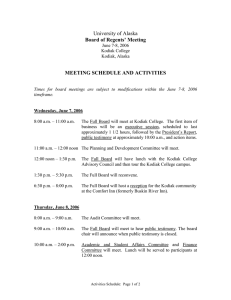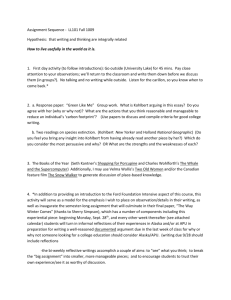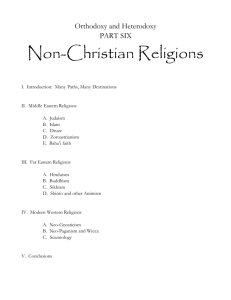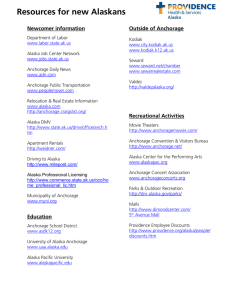Letter - St. Innocent`s Academy
advertisement
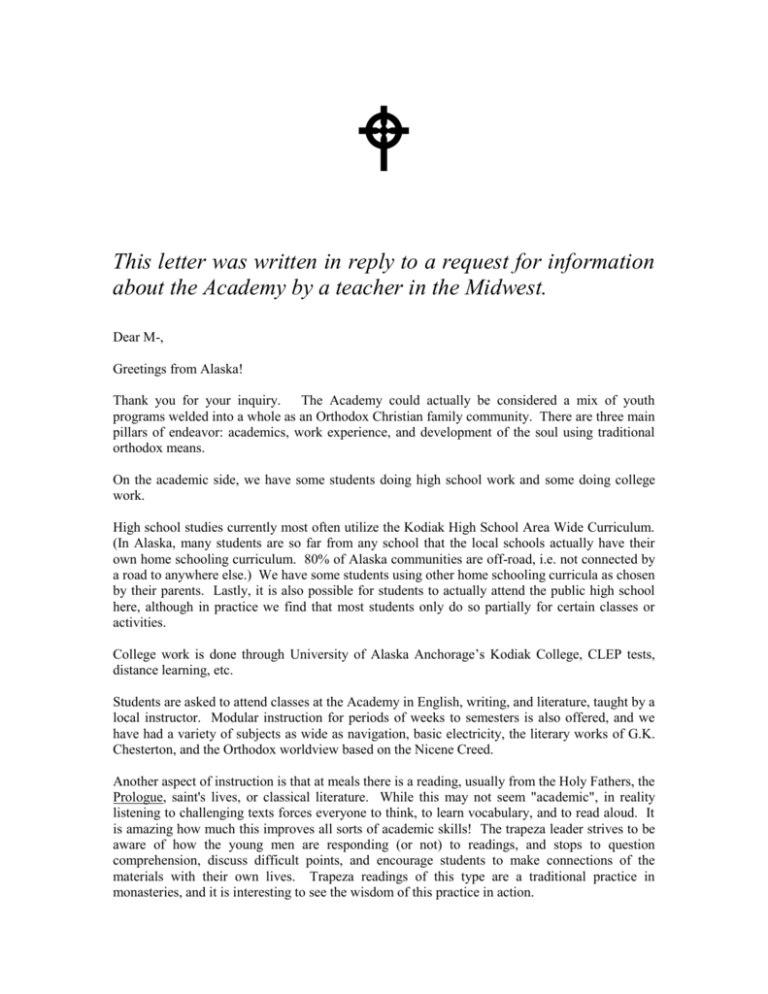
This letter was written in reply to a request for information about the Academy by a teacher in the Midwest. Dear M-, Greetings from Alaska! Thank you for your inquiry. The Academy could actually be considered a mix of youth programs welded into a whole as an Orthodox Christian family community. There are three main pillars of endeavor: academics, work experience, and development of the soul using traditional orthodox means. On the academic side, we have some students doing high school work and some doing college work. High school studies currently most often utilize the Kodiak High School Area Wide Curriculum. (In Alaska, many students are so far from any school that the local schools actually have their own home schooling curriculum. 80% of Alaska communities are off-road, i.e. not connected by a road to anywhere else.) We have some students using other home schooling curricula as chosen by their parents. Lastly, it is also possible for students to actually attend the public high school here, although in practice we find that most students only do so partially for certain classes or activities. College work is done through University of Alaska Anchorage’s Kodiak College, CLEP tests, distance learning, etc. Students are asked to attend classes at the Academy in English, writing, and literature, taught by a local instructor. Modular instruction for periods of weeks to semesters is also offered, and we have had a variety of subjects as wide as navigation, basic electricity, the literary works of G.K. Chesterton, and the Orthodox worldview based on the Nicene Creed. Another aspect of instruction is that at meals there is a reading, usually from the Holy Fathers, the Prologue, saint's lives, or classical literature. While this may not seem "academic", in reality listening to challenging texts forces everyone to think, to learn vocabulary, and to read aloud. It is amazing how much this improves all sorts of academic skills! The trapeza leader strives to be aware of how the young men are responding (or not) to readings, and stops to question comprehension, discuss difficult points, and encourage students to make connections of the materials with their own lives. Trapeza readings of this type are a traditional practice in monasteries, and it is interesting to see the wisdom of this practice in action. 2 Work is the second big component of our program. In addition to all sorts of household chores, all the young men learn various skills through hands-on experience. Construction, remodeling, maintenance, small engines (lawnmowers), car repair, taking care of horses, fishing, boat handling, etc. are all probabilities. Some young men want to learn a particular skill like diesel mechanics, so we will try to find a person for them to learn from and work with. Some of the older men work part-time jobs to pay for their tuition. The third component, living the Christian life, includes outreach and missionary activities that range from regular visits to the nursing home to helping people in the community who ask, to reaching out to troubled Kodiak young people. Keeping a spiritual journal, following the fasts and feasts of the church, the discipline of prayer, and looking at all aspects of their lives to see if they are really living a God-pleasing life encourages real growth. The reading of the church services also serves multiple purposes. We try to do as many of the services in the whole cycle of daily services (the Horologion) as possible. There is nothing more important than the steeping of the whole person in the Presence of God. As a side benefit, there is also the fact that the services are based on the Bible and the Psalms, include the whole teaching cycle of the church, contain sublime poetry and singing, and, again, contribute to increasing comprehension and reading skills as the young men take turns being the reader. We thus also train up church readers who know the services. Classical music, movies and books support basic growth in the soul, which has been neglected in many modern upbringings. The beauty of Alaska's land and water, and the opportunities to test themselves in its wilderness (with appropriate training) also contribute much to the young men. On the NOT list, we include no TV, radio, rock, rap; no drugs, cell phones, beepers, smoking, drinking; no skateboards, video games; and no profane images or logos on clothing. This makes for some rocky beginnings for some students as they detoxify from the world, but they get a lot of support, attention and love from staff and students alike. We have all had to give up favorite pieces of excessive worldliness! What I am not adequately conveying in all this is the lively spirit of the Academy. There is a wonderful freshness in the spontaneity of some of our days. I don't know how to explain it exactly except to say there is a sense that all sorts of things are possible, from an hour's notice that someone is going to take a boat ride to Monk's Lagoon to an urgent appeal from someone to move a boat, catch a loose horse, sing at the teen center, or do an impromptu send-off concert on the dock for someone departing on the ferry! Well, I have covered a lot of ground here, and you may have some more specific questions, so please let me know what you would like to know in further letters. In Christ, Donna Elizabeth Jones 03/2015

